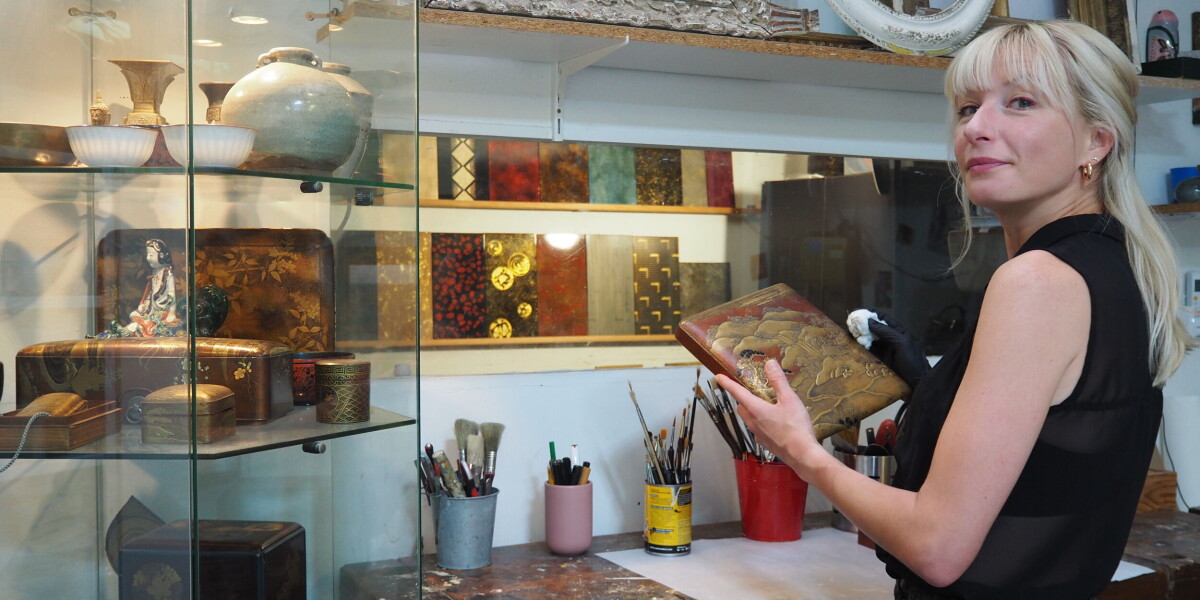
Reviving history with a modern touch 🖌️✨ discover atelier morganti's art of lacquer restoration!
- Select a language for the TTS:
- UK English Female
- UK English Male
- US English Female
- US English Male
- Australian Female
- Australian Male
- Language selected: (auto detect) - EN
Play all audios:

ATELIER MORGANTI IN NICE TRANSFORMS ANCIENT ARTEFACTS AND FURNITURE USING TRADITIONAL AND MODERN LACQUERING TECHNIQUES Atelier Morganti, situated in the Riquier district of Nice, has slowly
earned its stripes in the restoration business, re-lacquering everything from old furniture, jewels, boxes and frames, to Japanese armour. It is owned by Morgan Daniélou, who was born in
Roscoff and raised in Gouesnou (Finistère) and her husband Nicolas Morganti, who hails from Asnières-sur-Seine (Hauts-de-Seine). She graduated from Ensaama Olivier de Serres, one of the
most prestigious French decorative art schools, with a diplôme des métiers d'art. She went on to train at the Ateliers Brugier, a lacquer renovation workshop, where she took an
interest in Japanese antiques. However, her experience in restoration, decoration and furnishing has also given Ms Daniélou the technical background and artistic culture she needs to tackle
contemporary creations. Mr Morganti’s career journey, meanwhile, is altogether more unorthodox, having switched from a banker with BNP Paribas in Montreuil (Seine-Saint-Denis) to learn on
the job under Ms Daniélou. They are artisans d’art laqueurs – or lacquer craftsmen. Read more: The French craftsman making beautiful tiles for a Monaco landmark NEW BEGINNINGS It has been 11
years since the dark night on January 7, 2013 when they arrived in Nice with a truck packed full of all their worldly possessions and set up the business, keen for a new challenge. They
settled on Nicolas’s surname for the name of the firm as its Italian origins were judged a better fit for their new home in the south. “Daniélou is a Breton name. Morganti was a much sounder
choice,” laughed Ms Daniélou. Over the years, they have grown their business by learning new techniques and expanding the type of furniture they work on. Lacquer is used in a wide range of
applications, including architecture, interior design, furniture, objets d'art, small accessories and wall panels. “Our job is about giving back an object’s rightful value,” said Ms
Daniélou, but she is quick to dispel any romantic notions about what that involves – “50% of our job is about sanding,” she said. “The other 50% is split between decoration, lacquering and
cleaning,” added Mr Morganti. ART OF LAYERING As an example, they have a wooden board showing how the layers of lacquer look as they slowly build up. After each layer, the object is left to
dry for 24 hours before being sanded and the whole process repeated some 10 to 15 times. The precise amount of sanding and layers of lacquer required depends on the state each piece arrives
in. Other remedial work includes re-gluing weakened parts, repairing cracks and gaps, and restoring backgrounds and reliefs using a traditional coating. The couple work with traditional
Chinese lacquer, as well as more modern ones containing cellulose and polyurethane. It is sometimes combined with other materials, including gold, silver or copper leaf. Although she
professes to finding it easier to work without them, Ms Daniélou wears work gloves to protect her hands. She is more concerned, however, about the harmful effects that inhaling all the
chemicals they use will have on her lungs. Read more: Preserving tradition in every drop: The travelling French distiller ANCIENT SKILL SET Lacquering overlaps with many other skills
associated with the art of restoration, said Mr Morganti, citing cabinet-making, varnishing, marquetry and art expertise among them. A tour of their workshop gives a good feel for the range
of objects they enjoy working on; here a 17th-century coffee table, there a Japanese screen. Lately, the couple has worked on two doors from the Villa Ephrussi de Rothschild, a seaside villa
in Saint-Jean-Cap-Ferrat (Alpes-Maritimes) listed as a monument historique since 1996. The firm’s other clients include antique dealers, collectors, decorators, museums, and the state
through monumental art commissions. “Each piece is like a new adventure. It offers us great versatility,” said Ms Daniélou. This versatility is showcased on the couple’s Instagram page,
featuring close-up before/after photos of their work on a Louis XVth-inspired chest of drawers, a samurai sheath, a Japanese chest and a wooden, and a 15th-century Chinese sculpture. Among
the cabinets, screens and other furniture lies one item covered by a sheet in a corner of the workshop that the couple has been working on for several months. The Connexion was briefly shown
what was hidden underneath, but pledged to keep it a secret – the couple are planning a very big reveal in the near future. Watch this space. You can find Atelier Morganti at
morganti-laques.fr and on Instagram at @atelier_morganti.
